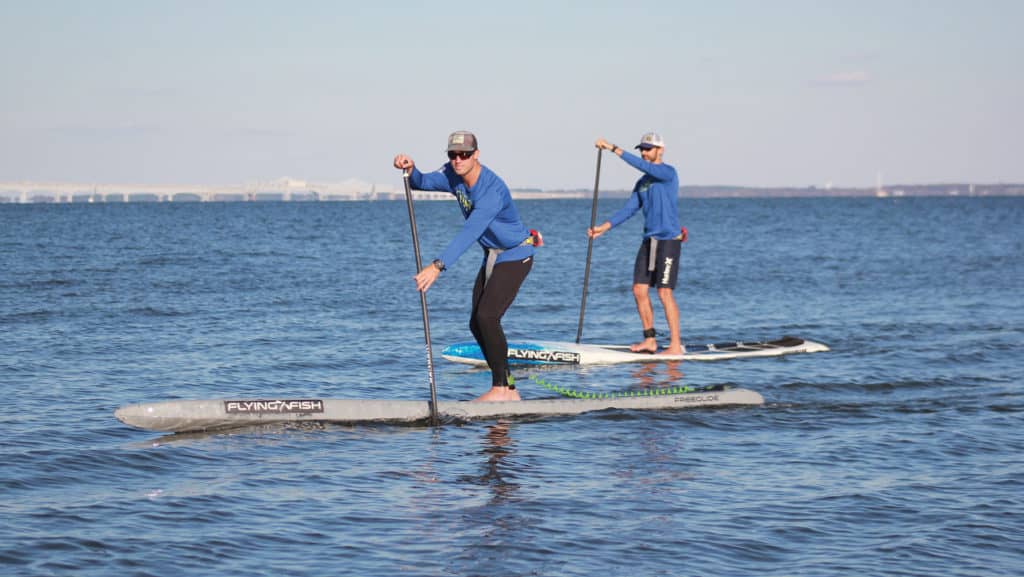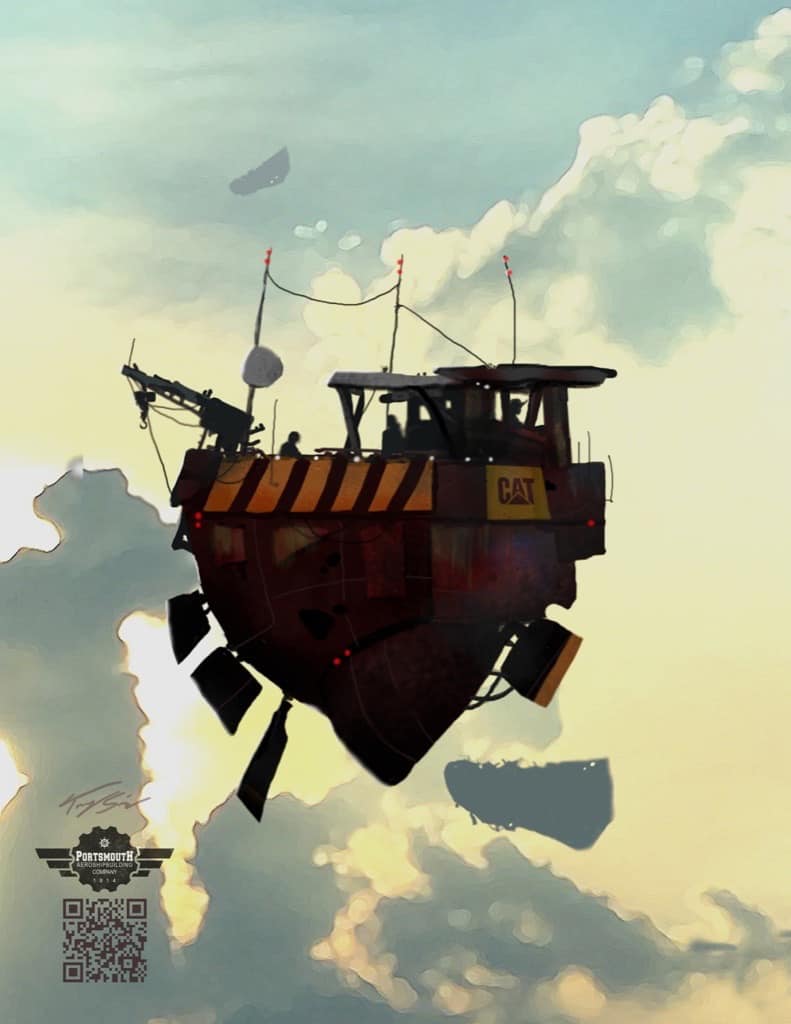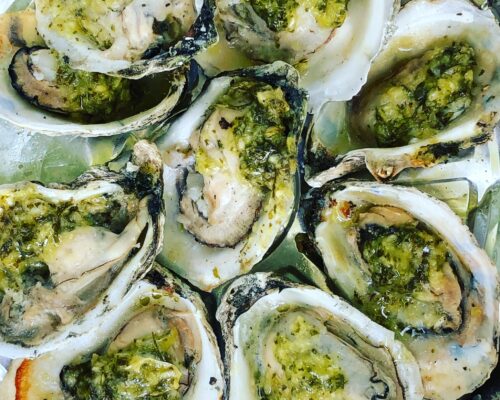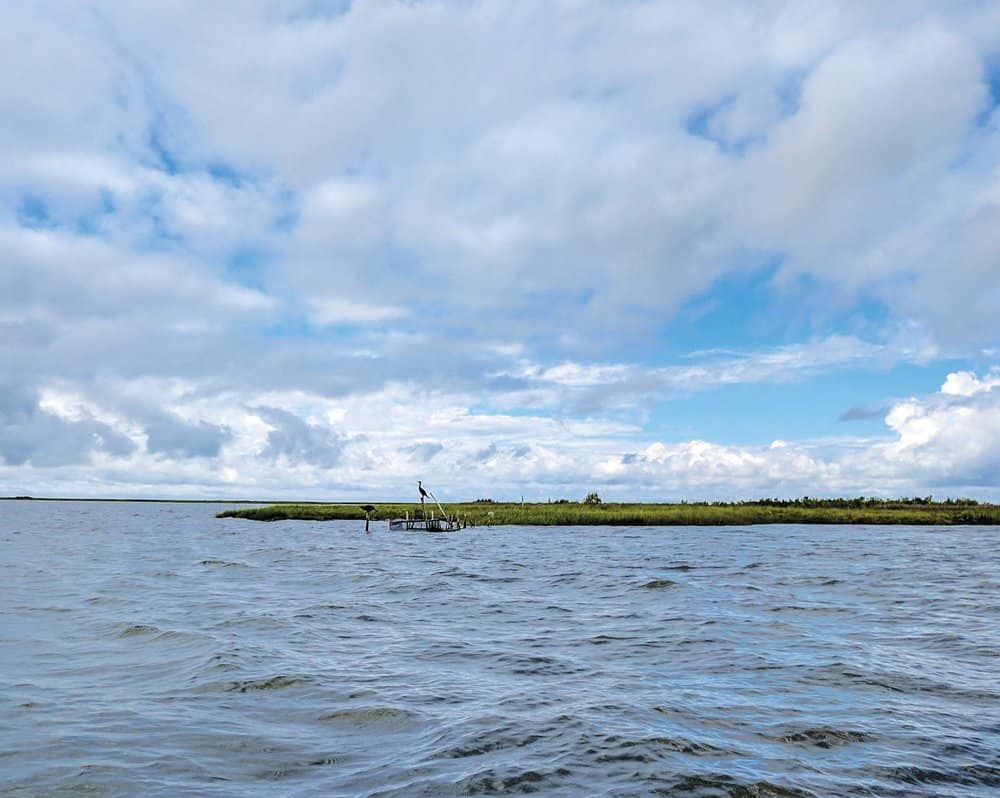Paddling the length of the Bay for oyster restoration.
What would it take to paddleboard the length of the Bay? And why would anyone do it?
Chris Hopkinson and Chris “Goose” Norman intend to answer those questions through the Bay Paddle, a mission-driven trek that will see them launch their high-tech, 16-foot, touring, standup paddleboards in Havre de Grace, at the top of the Bay, and make the roughly 240-mile trip to Virginia Beach, all to raise awareness and support for the Oyster Recovery Partnership (ORP).
Hopkinson was born and raised in Annapolis and always loved being near the Bay but didn’t discover paddleboarding until 2014 when his wife gifted him a board as a way to get brief breaks from their three-kid household.
“I grew up in Annapolis but never had a boat, so my board was actually the first time I could get on the water,” says Hopkinson. “You can see a lot standing on the water, and I love the unique perspective it provides.”
Norman, 31, also a native Annapolitan, got his sea legs at a young age by sailing and windsurfing on the Bay with his father. He began paddleboarding in 2012 and loved the sport so much that he turned it into a business, opening Capital SUP, a popular paddleboard and kayak rental outfit, with two friends in 2014.
“Paddleboarding is a great way to get on the water without the hassle of owning a boat,” says Norman. “It’s also great exercise and a unique way to see many different parts of the Bay.”
Hopkinson saw oysters as nothing more than an appetizer until a few years ago, when he discovered the shellfish’s importance to the Bay while replicating a video of oysters filtering water in an aquarium tank for his daughter’s elementary school science fair project.
“I never knew how important oysters were until I saw the video, learned that a single oyster filters 50 gallons per day, and actually watched them do it with my daughter,” explains Hopkinson.
Intrigued by the impressive work rate of the iconic Chesapeake bivalve, Hopkinson began reading more about oysters and ORP, the organization that made the video. He loved the active mission of the 26-year-old nonprofit, which works to restore the Bay’s oyster population through efforts including oyster habitat restoration, shell recycling, aquaculture, monitoring, outreach, and education. He loved it so much, in fact, that he decided he wanted to support it by doing something action-oriented and attention-grabbing—paddle the Chesapeake Bay with a goal of raising one million dollars for oyster restoration.
“I’ve always been concerned about the health of the Bay, but the challenge has really been understanding what I can do to help,” says Hopkinson. “So, after learning that the oyster population is down 99 percent from its historical levels, and that there used to be enough oysters to filter the entire Bay in just four days, I came to believe that bringing them back is the single most important thing we can do to help the Bay and every species in its ecosystem. And I know $1 million is an incredibly ambitious goal for a first-time event, but I figured, why start small? Just think—that would put 100 million oysters back in the Bay, filtering five billion gallons of water per day.”
After sending a brief email describing his “crazy idea” to ORP, Hopkinson landed a meeting with some of its staff who, he says, agreed that it was pretty crazy and seemed to think he was hoping to become “Oyster Gump,” akin to Forrest running across America. However, they soon realized how serious he was and decided to give him their support.
“We definitely thought the idea was a little out there and weren’t sure whether to take Chris seriously at first,” says Allison Albert Guercio, ORP Marketing Manager. “But as time progressed and he made more and more connections, [including getting Norman, whom ORP knew from working with Capital SUP on oyster-growing efforts in the past] to join him, we were happily on board. We loved the audacity of the idea, the adventure, and the opportunity to engage what will hopefully be a huge number of people in something that not only makes oyster education, awareness, and action interesting but also sets real, tangible goals.”
Guercio says the Bay Paddle will likely become ORP’s most unique fundraising effort to date, but the organization is no stranger to innovative collaborations. Its oyster restoration efforts receive a portion of proceeds from sales of Flying Dog Brewery’s Pearl Necklace Chesapeake Stout, Chesapeake Bay Roasting Company’s Eco-Reef and Oyster Reef Coffees, and the Chesapeake Collection clothing line, plus all proceeds from Baltimore-based TheQG.com Oyster Recovery Partnership necktie sales.
Chesapeake Bay Media, the parent company of this magazine, The Bay Bulletin, Bay Weekly and CBM Productions got a note from their friends at ORP about the project and immediately joined Capital SUP and Annapolis-based design firm Vim & Co as early sponsors. Chesapeake Bay Magazine editor in chief Joe Evans says, “As soon as we heard about the mission we did our research and discovered that these guys are the real deal. They’re experienced, prepared, and truly dedicated to making this work, so we felt like we had to jump in to support them.”
Guercio says ORP will take part in the lead-up to the paddle and the event itself. It has already worked with Hopkinson and Vim & Co to develop Bay Paddle branding and BayPaddle.org, where the public can learn about the work carried out by oysters and ORP, view the Bay Paddle itinerary, and make a 100-percent, tax-deductible donation to oyster restoration. ORP also intends to help Hopkinson and Norman organize and host awareness and fundraising events, from paddle-alongs to happy hours, throughout the summer, and finally joining them in portions of the Paddle itself.
Both paddlers recently completed Chattajack, a 31-mile paddle through the Tennessee River Gorge, and they recognize that paddling the length of the Bay in nine days will be an extreme physical and mental challenge. With that in mind, they’ll be putting in heavy hours of training over the summer on their light, carbon-fiber-on-foam, racing-style paddleboards, which feature pointed bows and rounded “displacement” hulls, which are designed for going long distances. They’ll also be praying for north winds and clear skies so that they can efficiently cover the following legs of what Hopkinson imagines could be the Chesapeake Bay’s version of the Appalachian Trail when they launch on September 18:
- Concord Point Lighthouse (Havre de Grace) to Fort Smallwood Park (Pasadena), 40 miles.
- Fort Smallwood Park to City Dock (Annapolis), 30 miles.
- City Dock to Chesapeake Beach, 25 miles.
- Chesapeake Beach to Cove Point Light Station (Lusby), 25 miles.
- Cove Point to Point Lookout Lighthouse (Lexington Park), 25 miles.
- Point Lookout to Hughlett Point Natural Area Preserve (Kilmarnock), 25 miles.
- Hughlett Point to New Port Comfort Lighthouse (Port Haywood), 30 miles.
- New Port Comfort to Old Point Comfort Lighthouse (Fort Monroe), 25 miles.
- Old Point Comfort to Cape Henry Lighthouse (Virginia Beach), 15 miles.
Hopkinson and Norman will ask the public to support them before and during the Paddle by training with them this summer, joining them on one or more legs of the paddle, or committing to complete individdual 200-plus-mile-challenges of choice (biking, running, walking, etc.). They hope businesses will do the same through donations of dollars or contributions of gear and equipment, ideally including a sponsored chase-boat to accompany them throughout the journey.
“The mission is to bring our community together around a cause that we all care about,” says Hopkinson. “So, when the paddle feels overwhelming, I’ll remind myself of how great a gift it is to grow up on the Bay, think about all of the people who’ve donated, and get my motivation from knowing that they’re cheering for us and the Bay.”




